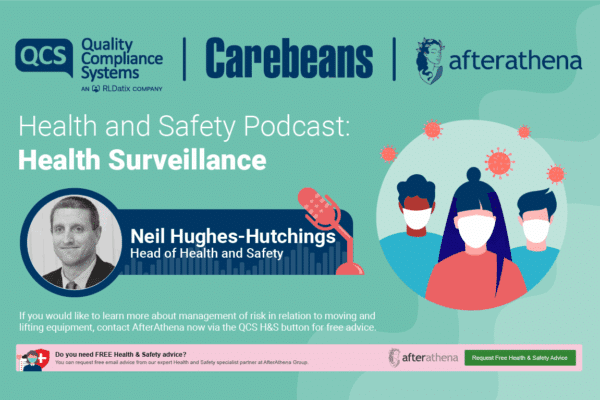As a care provider, it is your responsibility to ensure that allergen information is provided for the food you serve, but how much do care home staff and service users know about food allergy?
There is some evidence that food allergy and intolerance is on the rise. Research has also shown that the type of foods people are reacting to may be changing. For example, foods which are relatively new to the UK diet, like kiwi, are now being reported to cause food allergy in some people.
Allergic reactions can make people very ill and can occasionally lead to death, although this is rare; on average 10 people die each year in England and Wales from food allergy. Whilst this compares with 168 deaths from foodborne disease (food poisoning), more food-related hospital admissions are due to food allergy-related conditions.
The only way someone can avoid getting ill is to make sure they don’t eat the foods to which they are allergic. Residents of care homes are particularly vulnerable as they are reliant on others to provide their food, have a reduced immunity due to age and may not be able to directly communicate that they have a food allergy.
Food allergy differs from food intolerance
This month the Food Standards Agency published a comprehensive review on the area of food allergy and intolerance. This details the distinction between food allergy and intolerance, which is not well recognised by the general public. The main difference is that a food allergy directly involves the immune system whereas food intolerance is not caused or controlled by the immune system.
Certain foods can be responsible for both an allergic reaction and intolerance. For example, milk proteins can cause an allergic response in some people. A reduced ability to metabolise lactose, the sugar naturally present in cow’s milk, is called lactose intolerance.
Some people describe coeliac disease as a food allergy. However, it is an autoimmune condition, where the immune system mistakenly reacts to gluten in foods, attacks and causes damage to the gut. This affects the gut’s ability to absorb nutrients from food. Gluten is found in cereals such as wheat, rye and barley.
Depending on the food involved and the sensitivity of individuals, symptoms associated with food allergy or intolerance can appear immediately (within minutes). They can also take several hours or days to manifest. Symptoms can range from mild irritation to severe or life threatening anaphylaxis and may affect the skin, oral cavity, gastrointestinal tract, respiratory tract or the eyes.
Allergy and intolerance diagnoses
Self-reported food allergies and intolerances are much higher than those medically diagnosed. However, it is thought that in older people the latter may be underestimated and underdiagnosed. Allergy tests that are available on the high-street lack scientific evidence to show they work. Also, food allergies need to be diagnosed by doctors, preferably specialists in allergy, using medical histories, blood and skin prick tests.
There are no such tests for food intolerances; the only reliable way to diagnose one is under the supervision of a health professional. This is done by avoiding specific foods whilst keeping a diary to record exactly what is eaten and what symptoms are experienced.
What foods are people allergic to?
Although many foods can trigger an allergic reaction in a susceptible individual, some are more common than others. In the UK, allergies to peanuts, tree nuts (such as almond, walnut and hazelnut), wheat, cows’ milk, fish and egg are the most common.
The main allergens in Europe are the basis of the allergen regulations, and 14 require specific allergen labelling under EU law. This piece of European legislation is called the EU Food Information for Consumers Regulation (EU FIC), which came into force in December 2014.
The legislation requires food caterers such as care home caterers to inform service users, staff and visitors about the presence or use of any of the following 14 specified allergens as ingredients in any of the food that they serve:
Celery (celery stalks, leaves, seeds and the root celeriac)
Found in celery salt, salads, some meat products, soups and stock cubes.
Cereals containing gluten (e.g. wheat, oats, rye, barley, spelt, khorasan wheat/kamut)
Found in foods containing flour, such as some types of baking powder, batter, breadcrumbs, bread, cakes, couscous. Also found in meat products, pasta, pastry, sauces, soups and fried foods which are dusted with flour.
Crustaceans (e.g. prawns, crabs, lobster, crayfish)
Found in shrimp paste, often used in Thai and south-east Asian curries or salads.
Eggs
Found in cakes, some meat products, mayonnaise, mousses, pasta, quiche, sauces and pastries or foods brushed or glazed with egg.
Fish
Found in some fish sauces, pizzas, relishes, salad dressings, stock cubes and Worcestershire sauce.
Lupin
A flowering plant, but it can also be used in flour, more commonly in other parts of Europe.
Lupin flour and seeds can be used in some types of bread, pastries and in pasta.
Milk (including lactose)
Ingredient in butter, cheese, cream, milk powders and yogurt. It can also be found in foods brushed or glazed with milk, and in powdered soups and sauces.
Molluscs (e.g. mussels, squid and whelks)
Found in oyster sauce or as an ingredient in fish stews.
Mustard (liquid mustard, mustard powder and mustard seeds)
Found in curries, marinades, meat products, salad dressings, sauces and soups.
Nuts (e.g. almonds, hazelnuts, walnuts, cashews, pecan, Brazil nuts, pistachio, macadamia)
Found in some breads, biscuits, crackers, desserts, nut powders (often used in Asian curries), stir-fried dishes, ice cream, marzipan (almond paste), nut oils and sauces.
Peanuts
A legume (plant or fruit/seed) that grows underground (sometimes called a groundnut).
Found as an ingredient in some biscuits, cakes, curries, desserts, sauces (such as satay sauce), as well as in groundnut oil and peanut flour.
Sesame seeds
Found in some bread/breadsticks (sprinkled on hamburger buns for example), hummus, sesame oil and tahini. They are sometimes toasted and used in salads.
Soya (e.g. bean curd, edamame beans, miso paste, textured soya protein, soya flour or tofu)
Found in oriental foods, desserts, ice cream, meat products, sauces and vegetarian products.
Sulphur dioxide and sulphites (added at >10mg/kg or 10ml/L in the finished product)
Found in dried fruit such as raisins, dried apricots and prunes. You might also find it in meat products, soft drinks, vegetables, as well as in wine and beer. Those with asthma can have a higher risk of developing a reaction to sulphur dioxide.
Care providers need to be able to identify any individual with a food allergy or intolerance. They must also be able to provide them with food that is safe for their consumption, whether this is served directly to the resident or given to them to prepare themselves.
Allergen information should be easily accessible and readily available to individuals within your care. Food Standards Scotland advises you to do this by:
- Making service users and their families aware that you have allergen information available for all the food you provide to the residents in your care and families can ask to see this at any time.
- Developing a daily/weekly menu which declares the allergens contained in each meal and snack served to the residents, and share this with residents and their families and friends. This could be done online or on a notice/chalk board for residents.
Remember, as a duty of care and as a legal obligation food allergy needs to be recognised in care provision.






